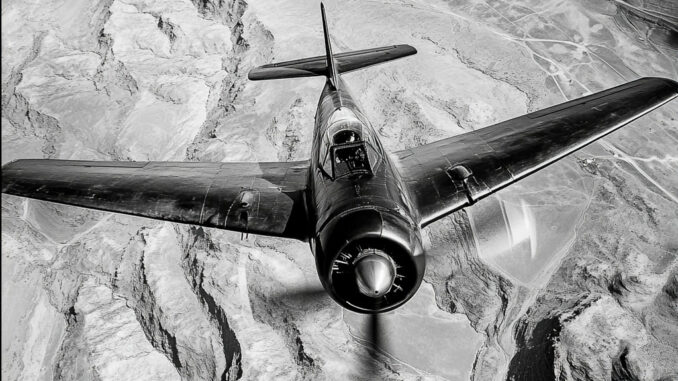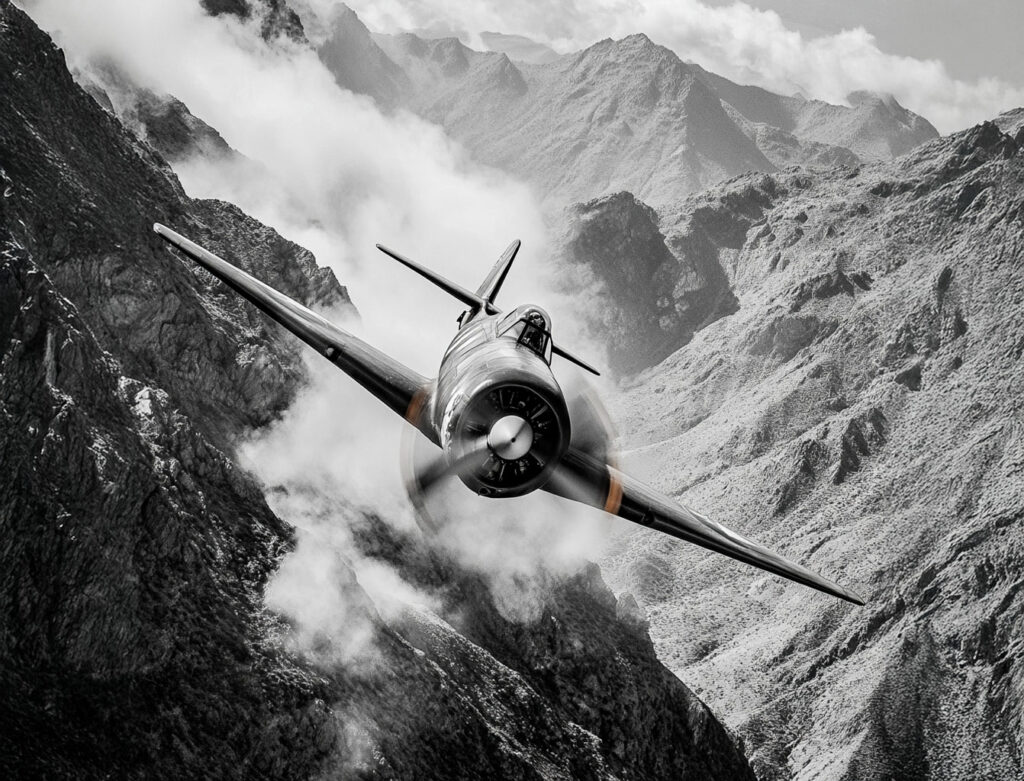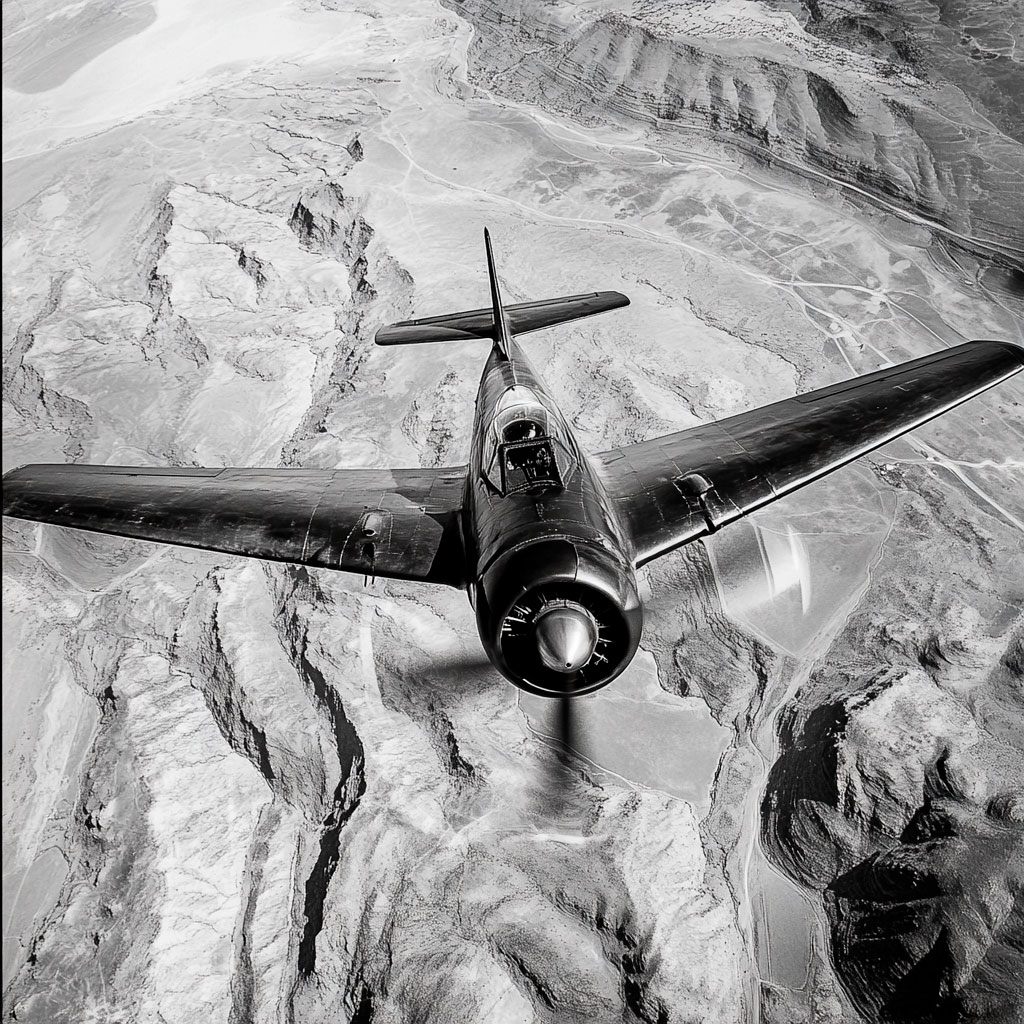
Detailed analysis of the use of French military aircraft in the Algerian War, including missions, aircraft used and strategic impact.
The Algerian War (1954-1962) saw the French air force play a decisive role in military operations. Faced with an insurgency without air power, the French air force optimized its resources for a variety of missions, from ground support to logistical transport.
Air support and bombing
French aviation played a central role in supporting ground troops during the Algerian war. The French Air Force deployed over 700 T-6G Texans, originally designed as trainers but modified for combat use. Armed with 7.5 mm machine guns, air-to-ground rockets and light bombs, the T-6G was used for close support and armed reconnaissance missions. It operated mainly in the mountainous areas of Kabylie and Aurès, where the rugged terrain limited the effectiveness of ground artillery. These aircraft carried out rapid strikes on FLN (Front de Libération Nationale) positions and guided ground troops by marking targets.
For operations requiring heavier strikes, France employed fighter-bomber aircraft such as the P-47 Thunderbolt, capable of carrying up to 1,100 kg of bombs and equipped with eight 12.7 mm machine guns. The B-26 Invader, a twin-engine bomber, was used for strategic bombing missions against weapons caches and rebel camps. The aircraft’s ability to carry bombs weighing from 250 to 500 kg enabled it to inflict significant damage on opposing positions, often hidden in steep terrain.

Reconnaissance and surveillance
The French air force set up a permanent aerial surveillance system to track the movements of FLN forces and anticipate their actions. The Dassault MD 315 Flamant, a twin-engine reconnaissance and liaison aircraft, played an essential role in these operations. With a range of 1,200 km and a cruising speed of 280 km/h, it could cover vast areas in a very short time. Its crew, generally comprising a pilot, an observer and a radio operator, was responsible for spotting enemy camps, supply routes and cross-border infiltration.
In addition, the air force employed Piper L-18s and Cessna L-19 Bird Dogs, light aircraft capable of low-level reconnaissance missions. Their low speed enabled them to make long flights over suspicious areas and direct air strikes or ground assaults with great precision.
The French air force also set up a network of aerial photographs to analyze changes in terrain and detect possible enemy movements. This information, combined with intelligence gathered by ground units, made it possible to adapt intervention strategies and optimize troop deployment.
Transportation and logistics
French aviation was a key element in the rapid movement of troops, the supply of forward bases and medical evacuation. Due to Algeria’s rugged terrain and the absence of suitable road infrastructure in certain regions, transport aircraft helped maintain a constant logistical flow between metropolitan France and the units deployed in the field.
The Nord 2501 Noratlas, a twin-engine wide-body aircraft, was the backbone of military air transport. Capable of transporting 6 tons of equipment or 45 fully-equipped soldiers, it was used extensively for airborne operations and cargo drops in isolated areas. The Douglas C-47 Dakota, older but still widely used, carried out similar missions, notably transporting reinforcements to combat zones and evacuating the wounded to military hospitals in Algiers and Constantine.
Between 1958 and 1960, transport aviation devoted 50% of its annual missions to Algeria, illustrating the importance of this logistical support. Aerial refueling enabled units engaged in the Aurès mountains and Kabylie to hold forward positions without having to rely on ground convoys vulnerable to ambush.
Use of helicopters
The use of helicopters profoundly transformed French military tactics in Algeria, enabling rapid and effective intervention in difficult-to-access terrain. The Aviation Légère de l’Armée de Terre (ALAT), created in 1954, deployed several helicopter models for a variety of missions: troop transport, medical evacuation, reconnaissance and command support.
The H-21C Piasecki, nicknamed the “Flying Banana” because of its elongated shape, was the aircraft most frequently used to transport infantry units. Able to carry up to 20 equipped soldiers, it enabled the implementation of heliborne tactics, reducing dependence on ground convoys vulnerable to FLN ambushes.
The robust and versatile Sikorsky H-34 was used for both logistical transport and medical evacuation. Its use made it possible to exfiltrate the wounded to military hospitals, considerably improving medical treatment times.
Attack helicopters like the Alouette II, armed with machine guns and sometimes rockets, played a major role in supporting ground troops. By December 1961, the ALAT had 453 helicopters in Algeria, illustrating their growing importance in French counter-insurgency strategies.
Border control and the Morice Line
Faced with FLN infiltration from Tunisia and Morocco, France set up a system to monitor and prohibit cross-border traffic. The most emblematic measure was the construction of the Morice Line, a 320 km-long electrified and mined barrier on the Tunisian border, later supplemented by the more sophisticated and better-defended Challe Line.
The Morice line was equipped with high-voltage (5,000 volts) electric fences, minefields and motion detectors. But the effectiveness of this system depended above all on aerial surveillance, carried out by helicopters and light aircraft. Alouette IIs and IIIs were used to spot FLN columns and guide ground troops, while Piper L-18s and Cessna L-19 Bird Dogs carried out day and night reconnaissance flights to detect illegal crossings.
Faster aircraft, such as the MD 315 Flamant, were used to observe large areas and alert ground units to suspicious movements. This air control, combined with ground forces, helped intercept numerous infiltrations, significantly reducing the flow of fighters and supplies into Algeria.

No air combat
The Algerian War was an asymmetrical conflict, in which the French air force enjoyed total control of the airspace. Unlike conventional conflicts, where two armies clash with comparable means, the FLN had no air force at its disposal, and was never able to oppose French forces with any kind of military aviation.
The only air threats came from small-calibre anti-aircraft guns, heavy machine guns and, more rarely, machine guns. The FLN used weapons such as the Soviet ZPU-2 14.5 mm cannon or the DShK 12.7 mm machine gun, capable of hitting low-flying targets. However, these defenses were limited in range and effectiveness against fast or medium-flying aircraft.
Faced with this threat, the French air force adapted its tactics by increasing the use of medium-altitude bombing with the B-26 Invader, rendering enemy fire ineffective. Ground support aircraft, such as the T-6 Texan and the P-47 Thunderbolt, often flew at low altitude, but took advantage of their speed and maneuvering to reduce the risk of being hit.
The absence of traditional air combat enabled the French air force to concentrate its efforts on reconnaissance, transport and ground attack missions, without fear of any adverse air response.
Significant incidents
Although in a position of total superiority, the French air force was involved in several significant incidents during the Algerian war. One of the most significant was the hijacking of the Air Atlas flight on October 22, 1956, an act which had major diplomatic repercussions.
On that day, five senior FLN leaders, including Ahmed Ben Bella, Mohamed Boudiaf, Hocine Aït Ahmed, Mohamed Khider and Mostefa Lacheraf, were travelling on board an Air Atlas DC-3 bound for Tunis. Their purpose was to attend a meeting with Tunisian President Habib Bourguiba and Moroccan King Mohammed V to discuss support for the Algerian insurgents.
French aircraft intercepted the plane in international airspace and forced it to land in Algiers, where the FLN leaders were immediately arrested. This operation, orchestrated by French intelligence services, provoked a diplomatic crisis with Morocco and Tunisia, who denounced it as a flagrant violation of international law. The incident also strengthened political support for the FLN on the international stage, helping to isolate the French position in the conflict.
Apart from this event, several French aircraft were hit by enemy fire, particularly during parachute missions or low-altitude attacks, but air losses remained limited due to the FLN’s weak anti-aircraft capability.
The French air force was a major asset in the Algerian War, offering undisputed air superiority. Its versatile role, encompassing ground support, reconnaissance, transport and border control, was essential to French military operations. The absence of an enemy air force enabled the air force to concentrate on missions of support and domination of the theater of operations.
War Wings Daily is an independant magazine.